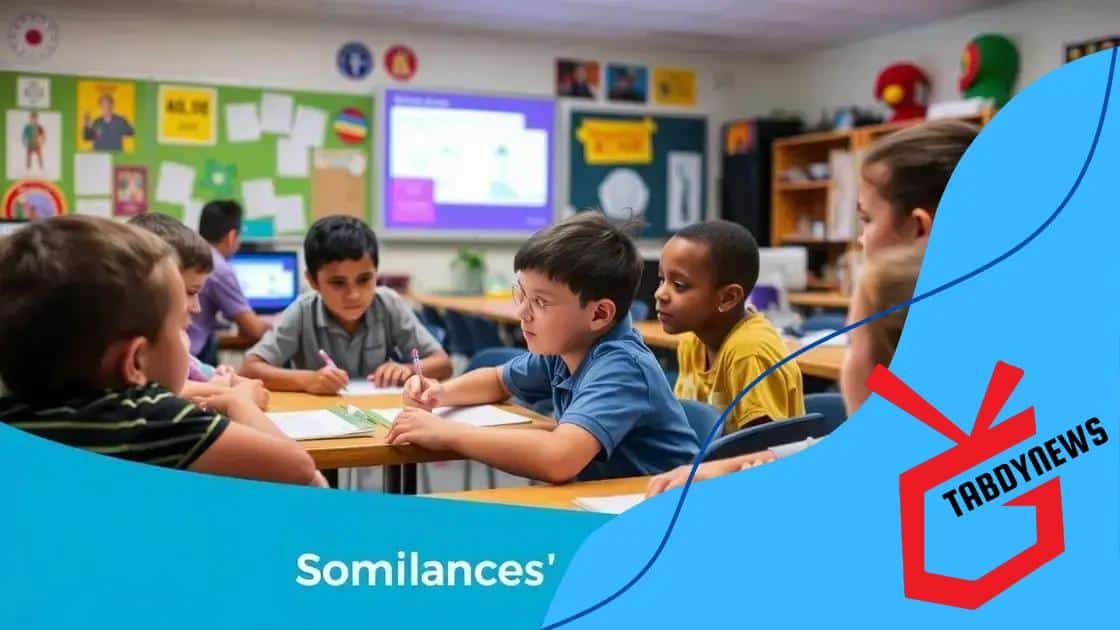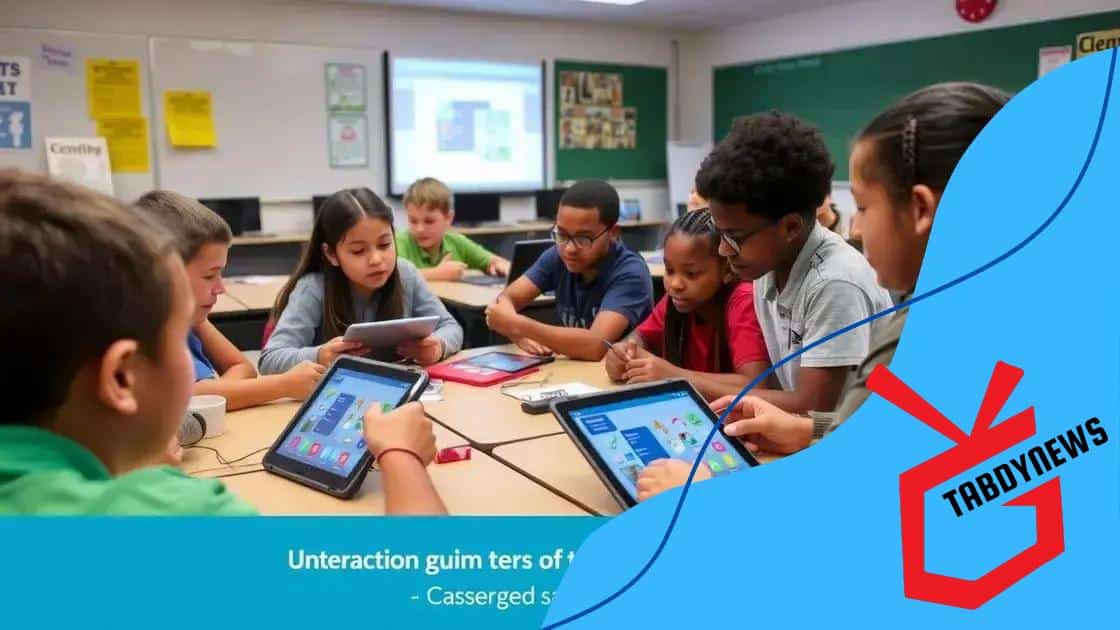Gamification to boost learning motivation effectively

Gamification enhances learning motivation by incorporating game elements like points, badges, and challenges, making education more engaging and interactive for students.
Gamification to boost learning motivation is becoming a game-changer in educational settings. Have you ever thought about how turning learning into a game could make it more enjoyable? Let’s dive into this innovative approach.
Understanding gamification and its principles
Understanding gamification and its principles is essential for enhancing learning experiences. By incorporating game-like elements into educational contexts, we can motivate students and make learning more interactive.
What is gamification?
Gamification refers to the use of game design elements in non-game contexts. This approach aims to engage and motivate individuals by tapping into their innate desire for competition, achievement, and rewards.
Core principles of gamification
Several key principles guide the implementation of gamification in learning:
- Challenge: Setting challenging tasks keeps students engaged.
- Feedback: Immediate feedback helps learners understand their progress.
- Reward systems: Offering rewards or points can motivate students to participate.
- Progress tracking: Visualizing progress keeps learners informed and driven.
By leveraging these principles, educators can transform the way students interact with learning materials. For example, incorporating leaderboards can create a healthy competitive atmosphere that encourages participation.
Additionally, incorporating storytelling elements can enhance the emotional connection learners have with the content. By framing lessons within a narrative, students are more likely to engage deeply.
The essence of gamification lies in creating an environment where learning feels less like a chore and more like an adventure. By making lessons enjoyable, we foster intrinsic motivation, which is crucial for long-term learning success.
The impact of gamification on learning
The impact of gamification on learning is profound, changing how students engage with educational content. By integrating game elements, learning becomes more enjoyable and effective.
Increased Engagement
One major impact is the increase in student engagement. When lessons feel like a game, students are more motivated to participate. Gamification creates a fun atmosphere that encourages collaboration and competition.
Enhanced Retention
Another significant benefit is improved information retention. Students who learn through interactive methods often remember the material better. Gamified activities reinforce concepts in a memorable way.
- Interactive quizzes: They make learning fun while testing knowledge.
- Badges and rewards: These incentivize students to reach their goals.
- Story-based lessons: They immerse students in content, making it relatable.
Moreover, gamification promotes self-directed learning. Students feel empowered to set their own goals and track their progress. This autonomy boosts confidence and fosters a growth mindset.
Additionally, the community aspects of gamification should not be overlooked. Leaderboards and team challenges encourage collaboration among peers, creating a supportive learning environment.
As educators continue to explore the potential of gamification, its impact on learning will likely expand. With technology evolving, new tools will emerge, further enhancing educational experiences.
Examples of successful gamification in education

Examples of successful gamification in education show how effective this approach can be in engaging students. Many schools and programs have adopted game-like elements to enhance learning experiences.
Kahoot!
Kahoot! is a popular tool that allows teachers to create interactive quizzes. Students answer questions using their devices, earning points for speed and accuracy. This game-like platform encourages friendly competition and makes learning fun.
Classcraft
Classcraft transforms the classroom into a role-playing game. Students create characters and work in teams to complete quests that align with their learning objectives. Points are earned for positive behavior and academic achievements, promoting collaboration.
- Character progression: Students level up their characters by completing assignments.
- Team dynamics: Collaboration is rewarded, increasing student interaction.
- Real-life skills: The game fosters problem-solving and teamwork.
Another great example is the use of gamification in language learning apps. Programs like Duolingo utilize points, levels, and coaching to motivate learners. Tracking progress with fun visuals keeps users engaged.
Incorporating a game-based learning approach not only enhances motivation but also fosters a supportive community among learners. For instance, students may work together to achieve collective goals in platforms like Edmodo, which allows peer interactions and feedback in a gamified environment.
As educators explore innovative ways to teach, these examples prove the effectiveness of gamification. The integration of fun, interactive elements captures students’ attention and makes learning a delightful journey.
Creating your own gamified learning experience
Creating your own gamified learning experience can be a rewarding process. It involves designing educational activities that incorporate game elements to enhance student engagement.
Define Learning Objectives
The first step is to clearly define your learning objectives. What do you want your students to learn? Knowing the outcomes will help you design activities that align with these goals. It ensures that your gamification efforts support the overall educational purpose.
Incorporate Game Elements
Next, think about adding various game elements. These could include:
- Points: Reward students for completing tasks or participating actively.
- Badges: Create badges for specific achievements, motivating students to reach set milestones.
- Challenges: Introduce challenges where students can apply their knowledge.
- Leaderboards: Display top performers to encourage healthy competition.
Using these elements can make assignments feel less like chores and more like fun activities. This transformation sparks excitement and participation among students.
Moreover, using storytelling can enhance engagement. Frame your lessons as part of a larger narrative. For instance, create a quest where students must complete certain tasks to progress in the story. This context can provide motivation and make the learning process more immersive.
Lastly, gather feedback from your students. Understanding their thoughts on the gamified activities helps you refine and improve future lessons. Regular adjustments ensure that the experience remains enjoyable and educational. By focusing on continuous improvement, you can keep students engaged and motivated throughout their learning journey.
Measuring the effectiveness of gamification in education
Measuring the effectiveness of gamification in education is crucial for understanding its impact on student learning. Various methods exist to evaluate how well gamified approaches work.
Setting Clear Metrics
To assess effectiveness, it’s important to define clear metrics. These may include:
- Engagement rates: Observe how often students participate in gamified activities.
- Performance scores: Compare students’ grades before and after implementing gamification.
- Retention rates: Track how much information students remember over time.
- Student feedback: Collect insights on how students feel about gamified learning experiences.
Tracking these metrics can help educators see the direct impact of gamification on learning. For example, if engagement rates rise significantly, it suggests that gamification captures students’ interest effectively.
Using Surveys and Assessments
Surveys can uncover how students perceive their learning environment. Additionally, regular assessments can help determine if students grasp the material. Implementing pre-tests and post-tests is another way to evaluate progress and knowledge retention over time.
It’s also beneficial to analyze student behaviors. Observing participation, collaboration, and motivation levels can reveal the strengths of gamified methods. Analyzing classroom dynamics helps gauge whether gamification fosters a positive learning atmosphere.
Ultimately, measuring effectiveness is an ongoing process. By regularly assessing these factors, educators can make informed adjustments to their gamified learning experiences. This continuous improvement helps maintain high levels of engagement and educational achievement.
FAQ – Frequently Asked Questions about Gamification in Education
What is gamification in education?
Gamification in education is the integration of game elements into learning experiences to enhance engagement and motivation.
How can gamification improve student performance?
By making learning enjoyable through competition and rewards, gamification encourages students to participate more actively, leading to better performance outcomes.
What are some effective gamification strategies for teachers?
Teachers can use points, badges, challenges, and storytelling to create immersive learning experiences that motivate students.
How can educators measure the success of gamification?
Educators can measure success through engagement rates, performance scores, retention rates, and student feedback to evaluate the effectiveness of their gamified strategies.





